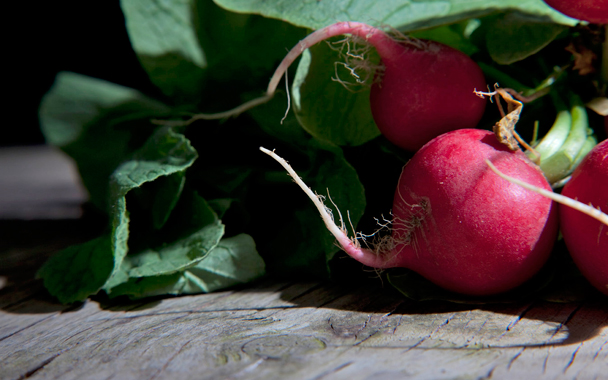Radishes, like Brussels sprouts, are vegetables that people tend to either worship or loathe. There doesn’t seem to be a middle ground. I love the funkiness of the little cabbages, which come close to cruciferous perfection in former Gourmet food editor Shelley Wiseman’s shredded Brussels sprouts with maple hickory nuts. But radishes? I just didn’t get the allure of their bite. So last year, when Stephen said he’d planted some in our garden, I pretty much shrugged and said, “Enjoy them.”
But then something happened to make me a radish convert. Simply put, they were the first to arrive—with few demands—at the garden party. They are forgiving of less-than-perfect soil; they can be planted a mere inch apart; they only take three to four days to germinate, and three to four weeks from germination to harvest; and many varieties can be seeded more than once a season (although they don’t do well in hot, dry weather). They remind me of the eager puppy who bounds toward you at an animal shelter, maybe not exactly the dog you had in mind, but when he’s in your face and his big round eyes are pleading, “Take me home,” how can you refuse?
When they were ready to harvest, we pulled the small red globes out of the ground, rinsed them off, sprinkled a little salt on them, and ate them out of hand. The bite was fierce, but the flavor was completely unlike any radish I’d eaten from the market. And I realized I’d never given these easygoing roots the fair shake they deserved. When a radish is fresh, it can be a contender.
In Japan, more radishes are grown than any other vegetable; the long (16- to 18-inch) white variety that we call daikon (also known as mooli) is the most popular. The Miyashige variety can be planted in July or August for a fall harvest, then pickled, cooked, sliced for a salad, or grated onto a variety of foods to add flavor. Another white variety that matures in the fall is the Munich Bier radish which, according to seed purveyor Cook’s Garden, is the perfect accompaniment to a frosted mug of German suds.
Certain varieties are best grown in spring, such as the yellow-skinned, white-fleshed heirloom ‘Helios,’ which is sweeter than your average radish. Slender red-and-white French Breakfast radishes can be sown in the spring or late summer. You could even grow radishes solely for the leaves, as many Chinese and Vietnamese do (using the Japanese variety ‘Bisai’), adding them to stir-fries and salads.
Whichever type you choose to grow, it’s important to harvest radishes as soon as they’ve matured; otherwise they’ll lose their crisp texture and mild flavor.
These qualities make radishes a natural choice for simple salads, such as this lovely mâche and frisée number. But how does a cook take radishes to a higher plane? Former Gourmet photo editor Danielle Vauthy Planells, a gardener who now grows three varieties of radish, and whose husband, Angel, is part Vietnamese, recreates her mother-in-law’s Vietnamese summer rolls using, she says, “everything from the garden—lettuce, mint, cucumber, and radish, which we roll with grilled shrimp or chicken. Those rolls are the best lunch for a hot day, since they are served cold.”
Food editor Ian Knauer also works the chill factor with a radish buttermilk soup, while Maggie Ruggiero (who has a competitive streak when it comes to cooking with avocados) uses the radish to bring a touch of heat to an avocado salad. And Melissa Roberts lets a radish just be a radish, by putting it in a pickle with rice vinegar, sugar, and fresh ginger.
The Radish File is getting thicker, and my onetime indifference is turning to, if not love, at least sincere affection for the vegetable that shows up early and often, with so much chutzpah it can’t possibly be ignored. And let’s face it: I’m a sucker for puppies and second chances.



 Pinterest
Pinterest


